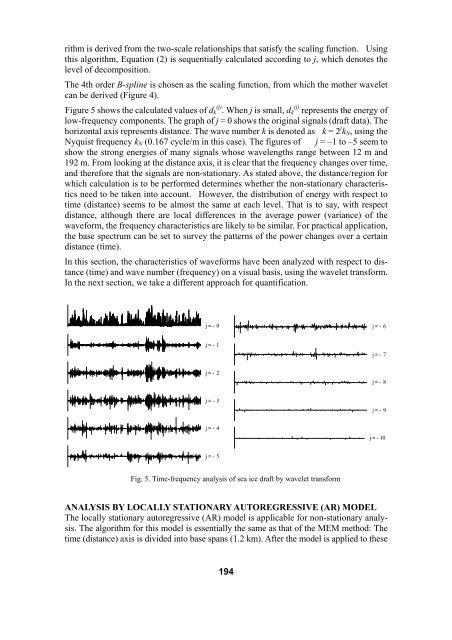Create successful ePaper yourself
Turn your PDF publications into a flip-book with our unique Google optimized e-Paper software.
ithm is derived from the two-scale relationships that satisfy the scaling function. Using<br />
this algorithm, Equation (2) is sequentially calculated according to j, which denotes the<br />
level of decomposition.<br />
The 4th order B-spline is chosen as the scaling function, from which the mother wavelet<br />
can be derived (Figure 4).<br />
Figure 5 shows the calculated values of d (j) k . When j is small, d (j) k represents the energy of<br />
low-frequency components. The graph of j = 0 shows the original signals (draft data). The<br />
horizontal axis represents distance. The wave number k is denoted as k = 2 j k N , using the<br />
Nyquist frequency k N (0.167 cycle/m in this case). The figures of j = –1 to –5 seem to<br />
show the strong energies of many signals whose wavelengths range between 12 m and<br />
192 m. From looking at the distance axis, it is clear that the frequency changes over time,<br />
and therefore that the signals are non-stationary. As stated above, the distance/region for<br />
which calculation is to be performed determines whether the non-stationary characteristics<br />
need to be taken into account. However, the distribution of energy with respect to<br />
time (distance) seems to be almost the same at each level. That is to say, with respect<br />
distance, although there are local differences in the average power (variance) of the<br />
waveform, the frequency characteristics are likely to be similar. For practical application,<br />
the base spectrum can be set to survey the patterns of the power changes over a certain<br />
distance (time).<br />
In this section, the characteristics of waveforms have been analyzed with respect to distance<br />
(time) and wave number (frequency) on a visual basis, using the wavelet transform.<br />
In the next section, we take a different approach for quantification.<br />
j =-0<br />
j =-6<br />
j =-1<br />
j =-7<br />
j =-2<br />
j =-8<br />
j =-3<br />
j =-9<br />
j =-4<br />
j =-10<br />
j =-5<br />
Fig. 5. Time-frequency analysis of sea ice draft by wavelet transform<br />
ANALYSIS BY LOCALLY STATIONARY AUTOREGRESSIVE (AR) MODEL<br />
The locally stationary autoregressive (AR) model is applicable for non-stationary analysis.<br />
The algorithm for this model is essentially the same as that of the MEM method: The<br />
time (distance) axis is divided into base spans (1.2 km). After the model is applied to these<br />
194

















